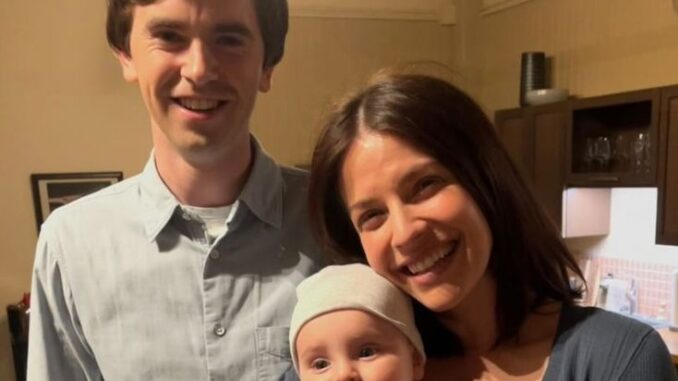
In a television landscape overflowing with romantic clichés, very few love stories feel original. Even fewer feel honest. But in The Good Doctor, the relationship between Dr. Shaun Murphy and Lea Dilallo dares to be both — a romance built not on perfection or chemistry alone, but on patience, misunderstanding, and unconditional acceptance. It is, without question, one of the most unconventional love stories on television today — and that’s exactly why it works.
Shaun, a brilliant young surgeon with autism and savant syndrome, isn’t a character written to fulfill traditional romantic fantasies. He struggles with social cues, hates physical touch, and cannot always process or express his feelings in ways his partner might expect. Lea, on the other hand, is spontaneous, emotional, and deeply expressive. On paper, they shouldn’t work.
And yet, episode after episode, we watch something miraculous unfold: a connection not defined by compatibility, but by commitment. Shaun and Lea’s story didn’t begin with a sudden spark. It began with two neighbors. They bonded over simple things — car rides, music, awkward conversations. Lea was the first person who made Shaun feel at ease outside of his mentor, Dr. Glassman. And while their early friendship was playful and light, it was always clear that Shaun saw her differently.

When he fell in love with her, it wasn’t a grand, sweeping moment. It was slow, confusing, and terrifying. For someone who lives in a world of logic and patterns, love was a wild card Shaun didn’t know how to handle. But he didn’t run from it — he tried to understand it. He read about it. He practiced. He asked for advice. And above all, he chose Lea. What makes their relationship so compelling is its rawness. There is no blueprint for how someone like Shaun should love — and The Good Doctor never pretends there is. The show doesn’t romanticize autism. It shows the real challenges that come with it, especially in relationships.
From disagreements about emotional expression, to Shaun’s fear of not being “enough,” to the anxiety both feel about physical intimacy, their relationship navigates territory most shows ignore entirely. And through it all, they grow — painfully, beautifully, authentically. There are breakups. There are misunderstandings. There is grief. When Lea loses their unborn child, the heartbreak nearly breaks them. Shaun, overwhelmed by the magnitude of loss and unsure how to comfort her, retreats inward. Lea, equally devastated, begins to question their future. And yet, even in that darkness, there’s no blame. Just pain. Just love.
Most love stories on TV revolve around big gestures: candlelit dinners, last-minute airport chases, dramatic declarations in the rain. Shaun and Lea give us something different. Their romance is defined by small, powerful moments. Like when Shaun plans a date down to the minute, because uncertainty makes him anxious. Or when Lea holds his hand — slowly, gently — knowing how much it takes for him to accept physical contact. Or when she learns to stop expecting him to say “I love you” in a typical way, and starts hearing it in the things he does instead.
This isn’t about dramatic flair. It’s about learning to speak love in someone else’s language — even when that language is foreign and takes time to learn. For viewers on the autism spectrum, or those in neurodiverse relationships, Shaun and Lea’s journey isn’t just emotional — it’s personal. It’s one of the few times television has reflected love in a way that includes them. Their relationship isn’t without flaws. Lea has made mistakes — from pushing Shaun too hard emotionally, to underestimating the depth of his needs. Shaun has struggled to make space for her feelings when they don’t align with his logic. But that’s what makes them real.
The show allows both characters to be wrong, to apologize, to grow. It refuses to flatten them into archetypes — the “quirky autistic genius” or the “supportive girlfriend.” Instead, it shows two people trying, failing, and trying again. And in a world where most romances are polished for comfort, theirs is refreshingly human.
When Shaun proposes — in his own unique way — it isn’t a fairytale moment. It’s a declaration of how far they’ve come. And when they marry, it doesn’t feel like a “happily ever after.” It feels like a beginning they’ve both fought for. Shaun and Lea’s love story matters because it makes space for difference. It shows that romantic love isn’t reserved for the neurotypical, the emotionally articulate, or the socially smooth. It reminds us that love can be messy, awkward, difficult — and still be deeply meaningful.
In a world quick to label people as “too much” or “too difficult,” their relationship says: You are worthy of love — exactly as you are. That message, delivered not through speeches but through shared struggles, is what makes their story unforgettable. More than any kiss or proposal, what defines Shaun and Lea is the daily decision to understand each other. To stay. To listen. To grow. In that, The Good Doctor gives us not only one of television’s most touching romances, but also a blueprint for what real, enduring love looks like — especially when it doesn’t look like what we expect.
